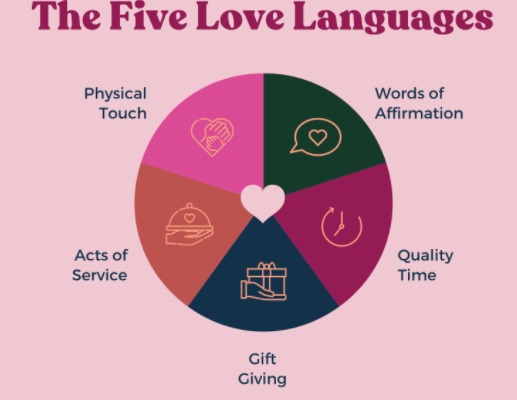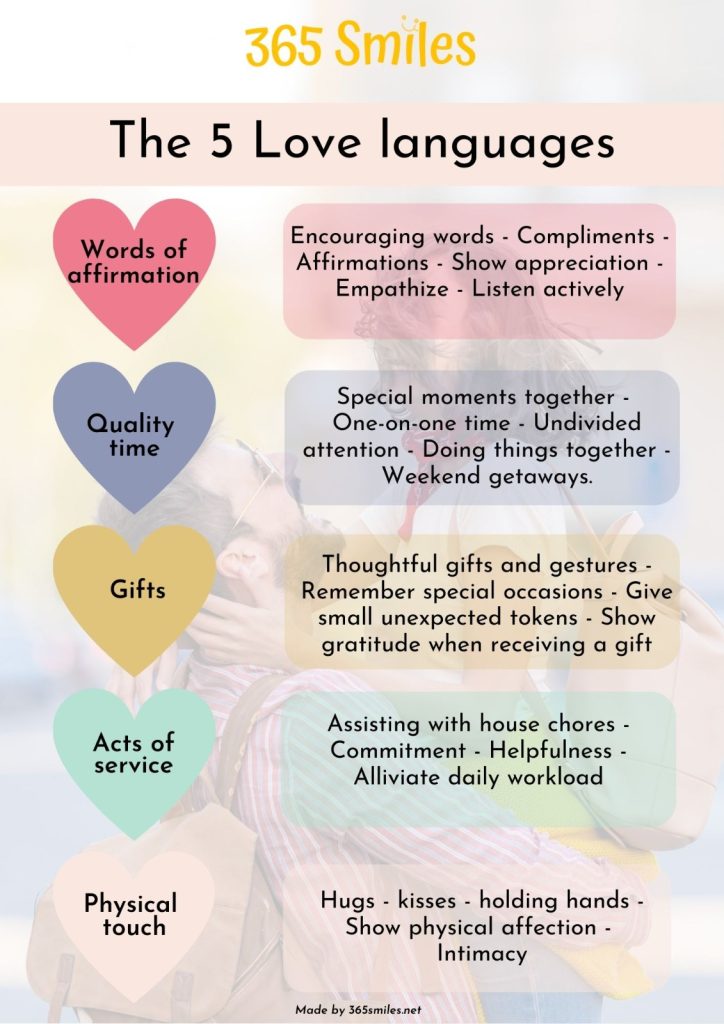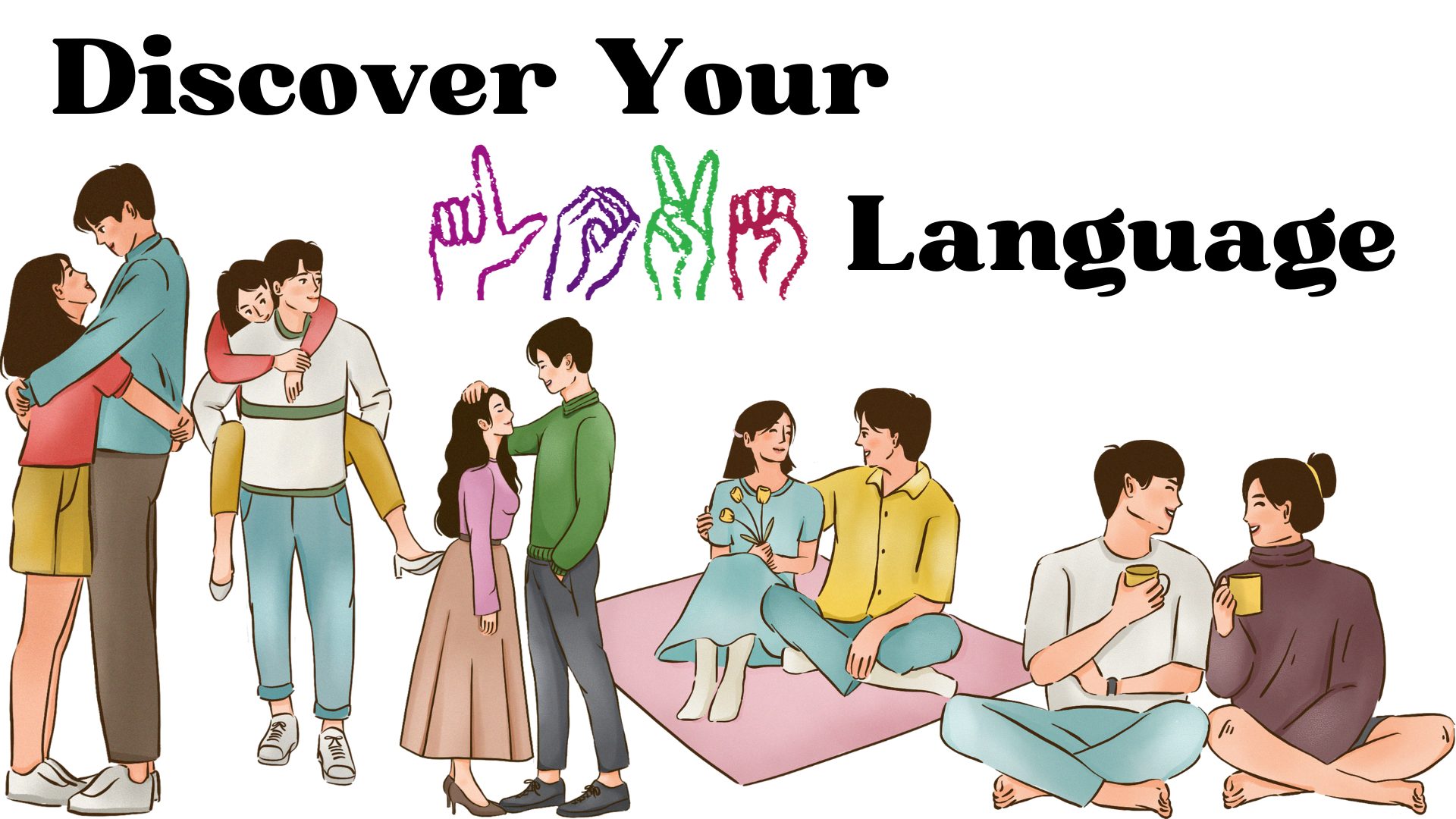Love Languages
Love Languages
In Gary Chapman's 1992 book, "The Five Love Languages: How to Express Heartfelt Commitment to Your Mate," we are introduced to the concept of five general ways to express and experience love in a relationship. It's important to recognize that the expression and reception of love are individual and unique to each person. Numerous studies surrounding this theory have validated the reality of love languages. Dr. Chapman's purpose in presenting this theory is to encourage both partners in a relationship to explore and understand each other's love languages. Dr. Chapman hypothesized that teaching couples to express love in ways that resonate with each individual, can lead to more harmonious and fulfilling relationships. It's essential to recognize that our love language may change over time, influenced by factors such as age, life experiences, needs, and trauma.

Types of Love Languages
Within the five love languages, there will typically be a primary love language that holds the highest value for each individual, followed by secondary and tertiary love languages. The five love languages include:
- Words of Affirmation
- Quality Time
- Physical Touch
- Acts of Service
- Receiving Gifts
Words of Affirmation
We often find words of affirmation to be the most common love language. This is because words of affirmation represent the only verbal expression of love language. This includes sharing positive words, compliments, and words of encouragement directly with them, uplifting their spirits. Writing a hand-written note of appreciation is also a beautiful act of words of affirmation. When we hear words of affirmation from our partner, we feel valued, happy, and fulfilled in the relationship. Moreover, using words of affirmation enhances communication between us and our partner, deepening our connection. On the receiving end, hearing words of affirmation helps us feel a sense of self-worth and motivation. It serves as a spirit booster and shows that our efforts are appreciated. Words of affirmation can have a profound impact on our relationship, fostering better communication, increased intimacy, and a greater sense of appreciation and self-esteem.
Quality Time
Next, quality time; spending quality time together. It's about expressing love and affection through undivided attention, intentionally setting aside time just for our partner, and making them feel loved, important, and cherished. While spending quality time together can be both easy and challenging, there are simple ways we can make it meaningful. During these moments, we strive to maintain eye contact and actively listen to our partner. It's not about the quantity of time we spend together, but rather the quality of our interactions. Even a brief 5-minute moment of meaningful and uninterrupted conversation can be more significant than spending 50 minutes together without genuine engagement. What matters most in quality time is how we are present and focused on our partner during those moments. When we value quality time, our partner feels loved and appreciated when we invest our undivided attention in them.
Physical Touch
For those of us who have physical touch as our love language, we tend to prefer physical expressions of love over other forms, such as verbal expressions. While sexual expression is indeed a common way to show love in romantic relationships, we recognize that it's not the sole aspect that defines a relationship. It holds importance, but it's not everything. Physical touch encompasses a wide range of expressions, including hugs, handholds, kisses, pats on the back, and even shoulder squeezes. These gestures hold great significance for us and make us feel loved and connected. The act of physical touch between two people releases oxytocin, often referred to as the "love hormone," which strengthens the bond between them. From cuddling to other forms of affectionate touch, we feel a deep sense of love and closeness through these physical connections.
Acts of Service
In our relationships, acts of service are a non-verbal way to express love by doing something thoughtful for our partner that they would truly appreciate. We understand that this love language can be more challenging to implement as it requires time and preparation. However, we recognize its significance in showing our love and care. Acts of service can involve paying attention to our partner's daily routines, such as noticing how much sugar they add to their coffee and considering taking on responsibilities that they may not enjoy, like doing the laundry, managing electrical gadgets, or preparing a meal. By offering our services according to our strengths, we can focus on acts that come more easily to us.
Receiving Gifts
In our relationships, the love language of receiving gifts is often misunderstood as being materialistic or focused on material things rather than the love for the person. However, the true essence of gift-giving lies in the sentiment behind it. For those of us with this love language, the size or cost of the gift doesn't matter; it's the thought and love behind it that holds the most significance. Even a small gift, such as a flower, a favourite snack, or a cup of coffee, can be cherished deeply by those with a love language for receiving gifts. These tokens of affection serve as reminders that we are loved and cared for. When our partner takes the time to select a gift that resonates with our interests and preferences, it makes us feel truly loved and understood.

Research on Love Languages
There are a few researchers who agree with Dr. Chapman's point of view and there are some researchers who disagree with it. Karandashev argues that love is universal but manifests differently according to different cultures. This theory was based on his own experience as a counselor and there was insufficient scientific study to prove the validity as there is not much research on the five love languages. According to research by Veale, knowing the partner's primary love language does not correspond with greater relationship satisfaction at the moment and also doesn't relate to greater satisfaction after three weeks. Dr Chapman's theory states that partners with aligned love languages should have better relationships. However, there is research found that there is no evidence that matching love languages helped them to have a more satisfying relationship.
On the other hand, the study of Egbert and Polk (2006) tested the validity of Dr. Chapman's theory on students as the first empirical support of the theory. Surijah and Septiarly's study in 2016 also showed a promising reliable score to validate the love languages theory as 17 items on the scale were valid. According to research on heterosexual and homosexual couples from Hughes & Camden in 2020, there will be an increased feeling of love and relationship satisfaction if they perceive their partner is using their love language.

Conclusion
There is research that does and doesn’t support the concept Dr. Chapman shares. The relationship is a complicated topic. The best approach to improving relationship satisfaction is to make science of our love language and set our relationship up for success. In order to improve our relationship, make sure we and our partner are clear with the preferences of each other and work together to achieve the mutually desired result.
If you enjoyed reading this, why not broaden the horizon of knowledge by learning about "Disenfranchised Grief"?
You can read the blog here.
For more content related to mental health do follow us on our official Instagram.


